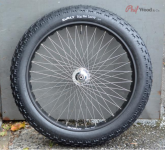ebike4healthandfitness
10 kW
- Joined
- May 19, 2012
- Messages
- 726
Now that ebikes are very common (particularly pre-built ebikes with machine built wheels) it would seem to me that the tradition of them borrowing classic 36 spoke wheels/rims from pedal bikes should be reconsidered.
First of all, even the smallest geared hub has a lot more space on it for spoke holes than the typical pedal bike hub (which usually has a PCD of around 45mm for the rear hub and because of this is limited to more or less 36 2.5mm diameter spoke holes).
Secondly, I'm seeing a lot of new bicycle rims now sporting machined out sections for the purpose of lightening the rim. Why not just use additional spoke holes for this purpose also? Even the super high spoke count "low rider" bicycle wheels I have seen still have room for a shrader valve despite the massively increased density of spokes added to the rim.
Thirdly, straight guage are really cheap and if enough of them are added it has the same effect of sharing the load as stiffening the rim or using thinner double butted spokes.
P.S. Something I noticed while checking prices on quality stainless steel spokes was that 15 straight guage was always cheaper than 14 straight guage. The 15 straight guage was usually 55 cents each compared to 75 cents for 14 straight guage. This in comparison to both 13/14 single butted and 14/15/14 double butted which were usually a dollar each.
First of all, even the smallest geared hub has a lot more space on it for spoke holes than the typical pedal bike hub (which usually has a PCD of around 45mm for the rear hub and because of this is limited to more or less 36 2.5mm diameter spoke holes).
Secondly, I'm seeing a lot of new bicycle rims now sporting machined out sections for the purpose of lightening the rim. Why not just use additional spoke holes for this purpose also? Even the super high spoke count "low rider" bicycle wheels I have seen still have room for a shrader valve despite the massively increased density of spokes added to the rim.
Thirdly, straight guage are really cheap and if enough of them are added it has the same effect of sharing the load as stiffening the rim or using thinner double butted spokes.
P.S. Something I noticed while checking prices on quality stainless steel spokes was that 15 straight guage was always cheaper than 14 straight guage. The 15 straight guage was usually 55 cents each compared to 75 cents for 14 straight guage. This in comparison to both 13/14 single butted and 14/15/14 double butted which were usually a dollar each.
Last edited:


